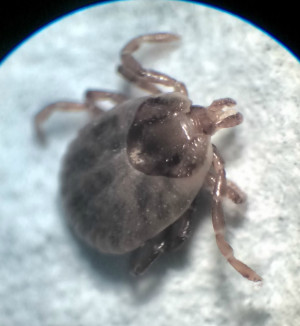Prevalence of gastrointestinal endoparasites and ectoparasites in ex situ snakes in Barranquilla, Colombia
Prevalencia de endoparásitos y ectoparásitos en serpientes ex situ en Barranquilla, Colombia.

Show authors biography
Objective. The aim of this study was to identify the prevalence of endoparasites and ectoparasites in ex situ snakes at the Barranquilla Zoo. Materials and Methods. Stool samples and ectoparasites of 2 colubrids (Leptophis ahaetulla and Spilotes pullatus), 2 diapsids (Oxybelys aeneus and Thamnodynastes paraguanae) and 13 boids (9 specimens of Boa constrictor, 2 of Epicrates maurus and 2 Eunectes murinus) were analyzed using flotation method in saturated sugar solution and direct observation. Results. The results showed that 65% (11/17) of the animals were positive to the presence of parasites. In relation to the positive specimens, 91% (10/11) belong to the Boidae family, presenting mostly nematodes, in the dipsadid’s samples mainly protozoans were observed and the colubrid’s samples were negative. Regarding ectoparasites, 2 species of ticks (Amblyomma dissimile and Ornothodoros turicata) were found in specimens of Boa constrictor, Epicrates maurus and Spilotes pullatus. Conclusions. The identification of parasites in this research represents a contribution to the study of parasitology in snakes ex situ in Colombia. It provides information to develop preventive measures against pathological agents and allows comparing results with other studies with animals in the wild and under human care.
Article visits 2142 | PDF visits
Downloads
- Mellish S, Ryan J.C, Pearson E.L, Tuckey M.R. Research methods and reporting practices in zoo and aquarium conservation-education evaluation. Conserv Biol. 2019; 33(1):40-52. https://doi.org/10.1111/cobi.13177
- Bais B, Tak L, Mahla S. Study of preventive health measures for wildlife in captivity: a review of management approaches. Int J Avian & Wildlife Biol. 2017; 2(3):73-75. https://doi.org/10.15406/ijawb.2017.02.00020
- Okulewicz A, Kaźmierczak M, Zdrzalik K. Endoparasites of exotic snakes (Ophidia). Helminthologia. 2014; 51(1):31-36. https://doi.org/10.2478/s11687-014-0205-z
- Villalobos F, Troncoso I, Loyola E, Robles A, Aguilar J, Fernández I et al. Determinación coproscópica de formas parasitarias en heces de ofidios: Boa constrictor y Python regius. Revista Científica FCV-LUZ. 2014; 24(5):454-457. URL Disponible en: http://produccioncientificaluz.org/index.php/cientifica/article/view/11805
- González D, Durán J, Cedeño J. Helmintos parásitos de Boa constrictor (Serpentes: Boidae) en el sur de Quintana Roo. Rev Mex Biodivers. 2014; 85(3):831-837. https://doi.org/10.7550/rmb.40515
- Wolf D, Globokar-Vrhovec M, Failing K, Rossier C, Hermosilla C, Pantchev N. Diagnosis of gastrointestinal parasites in reptiles: comparison of two coprological methods. Acta Vet Scand. 2014; 56(44): 1-13. https://doi.org/10.1186/s13028-014-0044-4
- Chávez L, Serrano-Martínez H, Tantaleán M, Quispe M, Casas G.C. Parásitos Gastrointestinales en Reptiles en Cautiverio en Lima Metropolitana. Rev Inv Vet Perú. 2015; 26(1):127-134. http://dx.doi.org/10.15381/rivep.v26i1.10909
- Novakova M, Literak I, Chevez L, Martins F, Ogrzewalska M, Labruna B. Rickettsial infections in ticks from reptiles, birds and humans in Honduras. Ticks Tick Borne Dis. 2015; 6(6):737–742. https://doi.org/10.1016/j.ttbdis.2015.06.009
- Carrascal J, Oviedo T, Monsalve S, Torres A. Amblyomma dissimile (Acari: Ixodidae) parásito de Boa constrictor en Colombia. Rev MVZ Córdoba. 2009; 14(2):1745-1749. https://doi.org/10.21897/rmvz.358
- Paternina L, Verbel E , Bejarano E. First report of Amblyomma dissimile (Acari: Ixodidae) on Spilotes pullatus (Squamata: Colubridae) from Colombia. Rev Inv Med Trop. 2015; 1(1):23-25. URL Disponible en: https://repositorio.unisucre.edu.co/handle/001/968
- Kassa D, Mengestie A, Ayalew N, Belaynew A, Mebrie Z, Metadel T. A Review on Diagnostic Techniques in Veterinary Helminthlogy. Nat Sci. 2016; 14(7):109-118. https://doi.org/10.7537/marsnsj140716.15
- Quiroz H. Parasitología. 4th. ed. Mexico D.F: LIMUSA S.A; 1990.
- Md-Robiul K, Fuchang Y, Jian L, Junqiang L, Longxian Z, Rongjun W et al. First molecular characterization of enteric protozoa and the human pathogenic microsporidian, Enterocytozoon bieneusi, in captive snakes in China. Parasitol Res. 2014; 113(8):3041-3048. https://doi.org/10.1007/s00436-014-3967-9
- Vergles A, Lindtner-Knific R, Vlahović K, Mavri U, Dovč A. Parasites in pet reptiles. Acta Vet Scand, 2011; 53(1):1-20. https://doi.org/10.1186/1751-0147-53-33
- Jepson, L. Medicina de animales exóticos guía de referencia rápida. 1ª. Ed. España: Elsevier; 2011.
- Rinaldi L, Mihalca A, Cirillo R, Maurelli M, Montesano M, Capasso M et al. Flotac can detect parasitic and pseudoparasitic elements in reptiles. Exp Parasitol. 2012; 130(3):282–284. https://doi.org/10.1016/j.exppara.2012.01.011
- Panayotova M. Parasites in captive animals: a review of studies in some european zoos. Zol Gart. 2013; 82(1-2):60-71. https://doi.org/10.1016/j.zoolgart.2013.04.005
- Scullion F, Scullion M. Gastrointestinal protozoal diseases in reptiles. J Exot Pet Med. 2009; 18(4):266-278. https://doi.org/10.1053/j.jepm.2009.09.004
- Nasiri V, Mobedi I, Dalimi A, Zare A, Ghaffarifar F, Teymurzadeh S et al. A description of parasites from Iranian snakes. Exp Parasitol. 2014; 147:7–15. https://doi.org/10.1016/j.exppara.2014.09.007
- Raś-Noryńska M, Sokół R. Internal parasites of reptiles. Ann Parasitol. 2015; 61(2):115-117. https://www.annals-parasitology.eu/go.live.php/download_default/D667/internal-parasites-of-reptiles.html
- Mogollón M, Pineda A, Benavides Y, Vargas L. Amblyomma dissimile en Boa constrictor en cautiverio del Centro de Atención y Valoración de Fauna Silvestre de Montería (Córdoba, Colombia). Rev Med Vet. 2017; (35): 29-34. http://dx.doi.org/10.19052/mv.4386
- Guerrero R, Rodríguez-Acosta A. Primer reporte de infestación de la serpiente reinita Erythrolamprus melanotus (Shaw, 1802) (Serpentes: Dipsadidae) por el ácaro Amblyomma dissimile Koch, 1844 (Acarina:Ixodidae) en Venezuela. Cuad Herpetol. 2014; 28(2):241-143. URL disponible en: http://ppct.caicyt.gov.ar/index.php/cuadherpetol/article/view/3052
- Mihalca A. Ticks imported to Europe with exotic reptiles. Vet Parasitol. 2015; 213(1-2):67–71. https://doi.org/10.1016/j.vetpar.2015.03.024
- Donaldson, T.G, Pèrez de León A, Li A, Castro-Arellano I, Wozniak W, Boyle W et al. Assessment of the Geographic Distribution of Ornithodoros turicata (Argasidae): Climate Variation and Host Diversity. PLOS Neglected Tropical Diseases. 2016; 10(3):e0004383. https://doi.org/10.1371/journal.pntd.0004383























